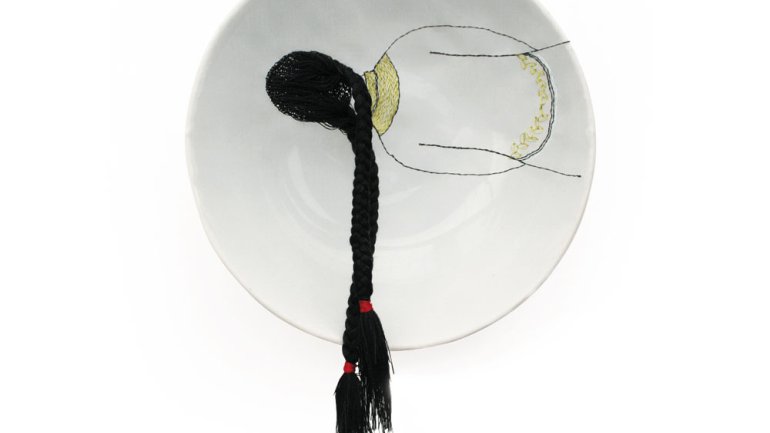Memory Keeper
Memory Keeper
Diem Chau might be described as a memory keeper. From her carved crayons, such as Girl in Green, that reflect on lost innocence, much like a broken crayon, to her embroidered partial figures on stretched cloth that covers discarded dishes, a renewal of an object’s previous life, the past is ever-present in her art.
Her own past has undeniably been a major influence. Chau, who was born to a Vietnamese mother and Chinese father, immigrated to the United States in 1986. It was an arrival long overdue. In 1978 Chau’s parents attempted to get out of war-ravaged Vietnam. However, they were caught by the Vietnamese coast guard and sentenced to a year each in jail. Chau’s mother, who was pregnant with her at the time, was given an early release, and after Chau’s birth they applied for U.S. immigration. Sponsored by her uncles, who’d successfully escaped to the U.S., they began the long, slow process of immigration. It took six years before the family could leave Vietnam; they then spent a year in a refugee camp in the Philippines before arriving in Seattle.
“I remember my first impression of the U.S. was, ‘Oh, it’s not that different here,’” muses Chau. “I heard so many fantasy stories about the U.S. like ‘The Gold Mountain’ and other grandeurs. I thought it’d be like Candy Land: the trees are made of lollipops, the streets are paved with gold and people fly around on swans. I was also seven and had an active imagination.”
This imagination may have sparked Chau’s artistic career. She can’t remember a time when art wasn’t part of her life. (“The pencil was my first toy,” she notes.) But it was Chau’s father’s death when she was in high school that really motivated her. “You only have one life,” she says. “Spend it doing what drives you to live.”
Chau attended Cornish College of the Arts in Seattle to study painting. Yet the medium left her slightly unsatisfied. “I also wanted to work with nonart materials,” she says. “I got tired of preaching to the choir. I love painting; it’s a very meditative process, but I couldn’t connect with the medium or end result. When I was done with a painting I was done.”
By using items from everyday life Chau touches on the fleeting moments of existence, something that all can relate to. The crayons tell the story of childhood innocence while the dishes reflect the bonds that form when people break bread together. Her work continues to head in new directions. While in the past she focused on her own experiences, she is now taking a broader look at human narratives.
“I took a step back from making work that was too personal because I wanted the viewers to be able to connect to it,” she says. “It’s a balancing act. I’ve also shifted my issues. Instead of loss, I focus on identity. It’s no longer about cultural erosion, but about defining my generation, understanding our differences while acknowledging our past. My work is one continuously evolving piece. I’m trying to capture a stream of consciousness.”




